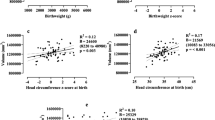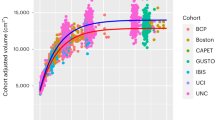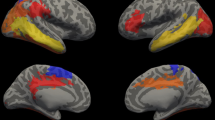Abstract
To examine whether birthweight and head circumference at birth are associated with childhood cognitive ability in South India, cognitive function was assessed using three core tests from the Kaufman Assessment Battery for children and additional tests measuring long-term retrieval/storage, attention and concentration, and visuospatial and verbal abilities among 505 full-term born children (mean age 9.7 y). In multiple linear regression adjusted for age, sex, gestation, socioeconomic status, parent's education, maternal age, parity, body mass index, height, rural/urban residence, and time of testing, Atlantis score (learning ability/long-term storage and retrieval) rose by 0.1 SD per SD increase in newborn weight and head circumference, respectively (p < 0.05 for all), and Kohs' block design score (visuospatial ability) increased by 0.1 SD per SD increase in birthweight (p < 0.05). The associations were reduced after further adjustment for current head circumference. There were no associations of birthweight and/or head circumference with measures of short-term memory, fluid reasoning, verbal abilities, and attention and concentration. In conclusion, higher birthweight and larger head circumference at birth are associated with better childhood cognitive ability. The effect may be specific to learning, long-term storage and retrieval, and visuospatial abilities, but this requires confirmation by further research.
Similar content being viewed by others
Log in or create a free account to read this content
Gain free access to this article, as well as selected content from this journal and more on nature.com
or
Abbreviations
- GDM:
-
Gestational diabetes mellitus
- HMH:
-
Holdsworth Memorial Hospital
- KABC:
-
Kaufman Assessment Battery for children
- SES:
-
Socioeconomic status
References
Victora CG, Adair L, Fall C, Hallal PC, Martorell R, Richter L, Sachdev HS, Maternal and Child Undernutrition Study Group 2008 Maternal and child undernutrition: consequences for adult health and human capital. Lancet 371: 340–357
Tanner JM 1990 Fetus Into Man: Physical Growth From Conception to Maturity. Harvard University Press, Cambridge
Webb SJ, Monk CS, Nelson CA 2001 Mechanisms of postnatal neurobiological development: implications for human development. Dev Neuropsychol 19: 147–171
Cooke RW, Lucas A, Yudkin PL, Pryse-Davies J 1977 Head circumference as an index of brain weight in the fetus and newborn. Early Hum Dev 1: 145–149
Hack M, Klein NK, Taylor HG 1995 Long-term developmental outcomes of low birth weight infants. Future Child 5: 176–196
Bhutta AT, Cleves MA, Casey PH, Cradock MM, Anand KJ 2002 Cognitive and Behavioural Outcomes of School-Aged Children Who Were Born Preterm: a meta-analysis. JAMA 288: 728–737
Shenkin SD, Starr JM, Deary IJ 2004 Birth weight and cognitive ability in childhood: a systematic review. Psychol Bull 130: 989–1013
Brennan TL, Funk SG, Frothingham TE 1985 Disproportionate intra-uterine head growth and developmental outcome. Dev Med Child Neurol 27: 746–750
Richards M, Hardy R, Kuh D, Wadsworth ME 2001 Birth weight and cognitive function in the British 1946 birth cohort: longitudinal population based study. BMJ 322: 199–203
Gale CR, O'Callaghan FJ, Bredow M, Martyn CN 2006 The influence of head growth in fetal life, infancy, and childhood on intelligence at the ages of 4 and 8 years. Pediatrics 118: 1486–1492
Heinonen K, Räikkönen K, Pesonen AK, Kajantie E, Andersson S, Eriksson JG, Niemelä A, Vartia T, Peltola J, Lano A 2008 Prenatal and postnatal growth and cognitive abilities at 56 months of age: a longitudinal study of infants born at term. Pediatrics 121: e1325–e1333
Silva A, Metha Z, O'Callaghan FJ 2006 The relative effect of size at birth, postnatal growth and social factors on cognitive function in late childhood. Ann Epidemiol 16: 469–476
Tong S, Baghurst P, McMichael A 2006 Birthweight and cognitive development during childhood. J Paediatr Child Health 42: 98–103
Broekman BF, Chan YH, Chong YS, Quek SC, Fung D, Low YL, Ooi YP, Gluckman PD, Meaney MJ, Wong TY, Saw SM 2009 The influence of birth size on intelligence in healthy children. Pediatrics 123: e1011–e1016
Grantham-McGregor SM, Lira PI, Ashworth A, Morris SS, Assuncao AM 1998 The development of low birth weight term infants and the effects of the environment in northeast Brazil. J Pediatr 132: 661–666
Villar J, Smeriglio V, Martorell R, Brown CH, Klein RE 1984 Heterogeneous growth and mental development of intrauterine growth-retarded infants during the first 3 years of life. Pediatrics 74: 783–791
Chaudhari S, Otiv M, Chitale A, Pandit A, Hoge M 2004 Pune low birth weight study—cognitive abilities and educational performance at twelve years. Indian Pediatr 41: 121–128
Yajnik CS, Fall CH, Coyaji KJ, Hirve SS, Rao S, Barker DJ, Joglekar C, Kellingray S 2003 Neonatal anthropometry: the thin-fat Indian baby. The Pune Maternal Nutrition Study. Int J Obes Relat Metab Disord 27: 173–180
Krishnaveni GV, Hill JC, Veena SR, Leary SD, Saperia J, Chachyamma KJ, Karat SC, Fall CH 2005 Truncal adiposity is present at birth and in early childhood in South Indian children. Indian Pediatr 42: 527–538
Sachdev HP 1997 Low birth weight in South Asia. In: Gillespie SR (ed) Malnutrition in South Asia: A Regional Profile. UNICEF, ROSA, Kathmandu, pp 23–50
Richards M, Hardy R, Kuh D, Wadsworth ME 2002 Birthweight, postnatal growth and cognitive function in a national UK birth cohort. Int J Epidemiol 31: 342–348
Hill JC, Krishnaveni GV, Annamma I, Leary SD, Fall CH 2005 Glucose tolerance in pregnancy in South India: relationships to neonatal anthropometry. Acta Obstet Gynecol Scand 84: 159–165
Carroll JB 1993 Human Cognitive Abilities: A Survey of Factor-Analytic Studies. Cambridge University Press, New York, pp 143–440
Kaufman AS, Kaufman NL 2004 Kaufman Assessment Battery for Children. 2nd ed. Manual. Pearson, San Antonio
Korkman M, Kemp SL, Kirk U 2001 Effects of age on neurocognitive measures of children ages 5 to 12: a cross-sectional study on 800 children from the United States. Dev Neuropsychol 20: 331–354
Kohs SC 1923 Intelligence Measurement: A Psychological and Statistical Study Based Upon the Block-Design Tests. Macmillan, Oxford, UK
Wigg CM, Duro LA 1999 The Koh's block tests as an important instrument to investigate the visuo-spatial impairments in myotonic dystrophy. Part I. Quantitative and qualitative analysis. Arq Neuropsiquiatr 57: 547–555
Wechsler D 1991 Manual for the Wechsler Intelligence Scale for Children. 3rd ed. Psychological Corporation, San Antonio
Malda M, van de Vijver FJ, Srinivasan K, Transler C, Sukumar P, Rao K 2008 Adapting a cognitive test for a different cultures: an illustration of qualitative procedures. Psychol Sci 50: 451–468
Malda M, van de Vijver FJ, Srinivasan K, Transler C, Sukumar P Traveling with cognitive tests: testing the validity of a KABC-II adaptation in India. Assessment 2009. [Epub ahead of print.]
International Institute for Population Sciences (IIPS) and Operations Research Centre (ORC) Macro 2001 National Family Health Survey (NFHS-2), India 1998–1999. Karnataka, Mumbai, IIPS, pp 24–31
Cole TJ, Green PJ 1992 Smoothing reference centile curves: the LMS method and penalized likelihood. Stat Med 11: 1305–1319
Martyn CN, Gale CR, Sayer AA, Fall C 1996 Growth in utero and cognitive function in adult life: follow up study of people born between 1920 and 1943. BMJ 312: 1393–1396
Sorensen HT, Sabroe S, Olsen J, Rothman KJ, Gillman MW, Fischer P 1997 Birth weight and cognitive function in young adult life: historical cohort study. BMJ 315: 401–403
Yajnik CS 2004 Obesity epidemic in India: intrauterine origins?. Proc Nutr Soc 63: 387–396
Klenberg L, Korkman M, Lahti-Nuuttila P 2001 Differential development of attention and executive functions in 3-to-12 year old Finnish children. Dev Neuropsychol 20: 407–428
Valencia RR, Rankin RJ 1986 Factor analysis of the K-ABC for groups of Anglo and Mexican American children. J Educ Meas 23: 209–219
Lawlor DA, Bor W, O'Callaghan MJ, Williams GM, Najman JM 2005 Intrauterine growth and intelligence within sibling pairs: findings from the Mater-University study of pregnancy and its outcomes. J Epidemiol Community Health 59: 279–282
Vernon PA, Wickett JC, Bazana PG, Stelmark RM 2000 The neuropsychology and psychophysiology of human intelligence. In: Sternberg RJ (ed) Handbook of Intelligence. Cambridge University Press, Cambridge, pp 245–264
Bartholomeusz HH, Courchesne E, Karns CM 2002 Relationship between head circumference and brain volume in healthy normal toddlers, children and adults. Neuropediatrics 33: 239–241
Drachman DA 2002 Hat size, brain size, intelligence and dementia: what morphometry can tell us about brain function and disease?. Neurology 59: 156–157
Castellanos FX, Lee PP, Sharp W, Jeffries NO, Greenstein DK, Clasen LS, Blumenthal JD, James RS, Ebens CL, Walter JM, Zijdenbos A, Evans AC, Gledd JN, Rapoport JL 2002 Developmental trajectories of brain volume abnormalities in children and adolescents with attention-deficit/hyperactivity disorder. JAMA 288: 1740–1748
Gale CR, Walton S, Martyn CN 2003 Foetal and postnatal head growth and risk of cognitive decline in old age. Brain 126: 2273–2278
Toga AW, Thompson PM 2005 Genetics of brain structure and intelligence. Annu Rev Neurosci 28: 1–23
Gale CR, O'Callaghan FJ, Godfrey KM, Law CM, Martyn CN 2004 Critical periods of brain growth and cognitive function in children. Brain 127: 321–329
Acknowledgements
We thank the families who participated in the study and Dr BDR Paul (former Medical Director). We also thank the substantial contribution made to the study by Annamma, Baby, Devaki, Lalitha, Lalithakala, Savitha, Gopal Singh, Prathibha, Asha, Jayakumar, Saroja, Geetha, Chachyamma, Stephen, Nalinakshi, Rumana, Jane Pearce, and Patsy Coakley.
Author information
Authors and Affiliations
Corresponding author
Additional information
Supported by the Parthenon Trust, Switzerland, the Wellcome Trust and Medical Research Council, United Kingdom.
Rights and permissions
About this article
Cite this article
Veena, S., Krishnaveni, G., Wills, A. et al. Association of Birthweight and Head Circumference at Birth to Cognitive Performance in 9- to 10-Year-Old Children in South India: Prospective Birth Cohort Study. Pediatr Res 67, 424–429 (2010). https://doi.org/10.1203/PDR.0b013e3181d00b45
Received:
Accepted:
Issue date:
DOI: https://doi.org/10.1203/PDR.0b013e3181d00b45
This article is cited by
-
Prenatal exposure to trans fatty acids and head growth in fetal life and childhood: triangulating confounder-adjustment and instrumental variable approaches
European Journal of Epidemiology (2022)
-
Developmental trends in early childhood and their predictors from an Indian birth cohort
BMC Public Health (2021)
-
Association between head circumference at two years and second and fifth year cognition
BMC Pediatrics (2021)
-
Does in utero HIV exposure and the early nutritional environment influence infant development and immune outcomes? Findings from a pilot study in Pretoria, South Africa
Pilot and Feasibility Studies (2020)
-
Head circumference at birth and school performance: a nationwide cohort study of 536,921 children
Pediatric Research (2020)



